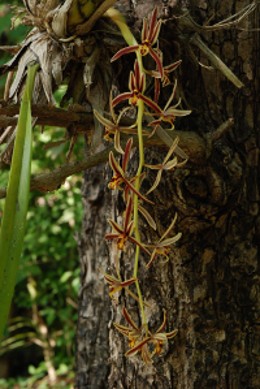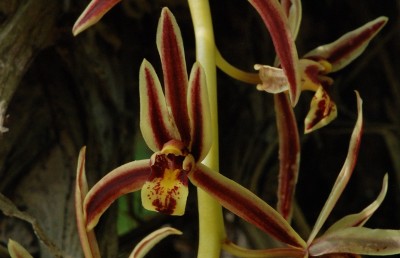Species of the Month – July 2014
Cymbidium Swartz
Cymbidium – From Greek kymbes, for boat shaped or a open boat! This has reference to the somewhat boat shaped lip or labellum of the flowers. This genus has around sixty seven sympodials species. Many of them are epiphytes and terrestrials. There are rare saprophytes as well. These are warm to cool growing often found in low to high elevation, hills, semi-deciduous/deciduous forests and scrubs. Twenty four species from this genus are supposed to occur from India. Due to floral shape and coloration these are used extensively in hybridisation as well.
Cymbidium bicolor Lindl.
Synonyms: Cymbidium bicolor subsp. bicolor
Cymbidium bicolor Lindl. is on the three Cymbidium species found in Karnataka. It can be seen growing in huge clumps on trees in

forests at mid elevation. The species usually starts flowering in the month of April and continues into May and sometimes June. However the flowering ends before the monsoons start in the Western Ghats.
Flower: This species features long pendulous inflorescence with numerous flowers. The flowers are sparsely arranged on the inflorescence. The flowers are usually bright, big and of around one inch plus in width. The petals and sepals usually have bright yellow margins and they are spread out.
Plant and Habitat: Being a sympodial epiphyte this can be seen growing on tree trunks in deciduous forests. Its observed that some clumps grow very big and surround entire trunk. This can be a metre or so in width. Having a pseudo-bulbs are short and compressed and the leaves are many and long and wavy. The leaves have a leathery feel when touched and they are thick surviving mainly direct sun light and drier weather conditions.

Cultivation: Being a hardy grower its popular in cultivation as well. Its also popular due its showy, bright coloured flowers. As the plant size grows, the number of inflorescence goes up as well. Good air circulation and lot of sunlight will help in its growth.
References:
1. Wild Orchids of Karnataka by Dr T Ananda Rao, S Sridhar
2. Illustrated Dictionary of Orchid Genera by Marie Selby Botanical Gardens
Article by : Ravee Bhat
Please give me medical properties.
information on medicinal imporatnce of cymbidium bicolor